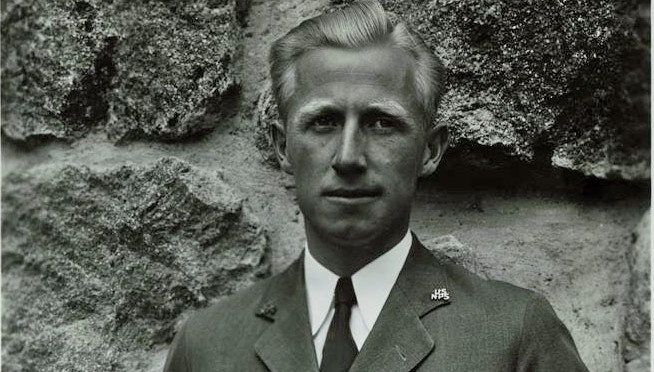I would like to talk a little about the intent and the desire of our designs in landscaping the grounds of the main building. The Crater Lake area offered an opportunity to embody the use of these existing materials in the construction of our main buildings. There were many areas at the base of Crater Lake where stones had accumulated over the year which made a good area to pick out desirable boulders and stones of different shape to use in the design of our buildings. Consequently, such building as the rangers dormitory, they administration building, and many of the residences at park headquarters were built, or rather, they were designed basically using these massive stones and using the heavy timbers of the roof structures to give, when completed, a building that would complete and satisfy the existing terrain, thereby blending into it. We encountered a number of construction problems in following about this intent of creating a good landscape design. Many of the sites that we chose had to be well selected whereby there would be adequate drainage. We tried to orient building that the prevailing snow would not create unusual weight conditions on the roofs of these structures. In fact, when we designed out pitched roofs of the structures we always tried to establish a certain degree of slope which would not permit snow to accumulate, but to slide off. But, even this best of efforts did not prevent the snow from accumulating on the buildings which in time had to be removed by other means. Our intent in using the stones, however large they might be…we tried to make it not a straight line construction, but to have the feeling that the stone generated up from the ground in a kind of sloping curve rather than to have a hard, straight, stone line coming down to the ground. And, by doing that, gave the impression to one observing these building that the building were modeled, so to speak, with the terrains of the rock and the soil. This proved difficult at times, but I think our end result justified the careful thought that we gave at the time. I do want to say that at this early stage in the ’30’s many of these buildings, as I have mentioned, were built by public works assistance and the grateful help of the CCC which appeared cheap labor at the time, which it was, due to the economy, but in later years turned out to be an excellent investment of what can be done even by the simplest of means, and rather than going into an expensive design architecture which would not have produced a better result of what we got in our manner of approach. I think another asset in the landscape approach to these buildings were applied not only to the building themselves, but we retained the same blending complex with roads that were built, parking area that were built, and I’m giving special reference to the Rim Road around Crater Lake which at one time was a pumice dirt road prior to the ’30s. But after about ’32 on, when the Bureau of Public Roads came in, and working with the assistance and the direction of the landscape architects in the National Park Service we were able to agree upon a lot of the landscape techniques which would be employed in the location of new roads. We participated, on all occasions, with location of roads to be built, we made selections of parking areas along these road areas, we designed retaining wall view points, we did extensive planning, but I will say the planning around the rim road area itself was quite difficult because of the heavy winds that prevailed much of that open area. But, our landscape results were quit successful, because when the road was completed, it was a beautiful road to travel over. Beautiful spots to view. And I think of such lovely spots as Kerr Notch, which is an excellent view point along with the many other excellent view points along the rim. I would like to give some comment to Vidae Falls. Vidae Falls in its natural state was a lovely natural creek bed flowing from an over cropping of rock and cascading down through a shallow valley. We did much to retain the beauty of Munson Valley, putting in extensive fill area and eventually landscaping and planting trees. This work was done in about ’36 and ’37. And as one goes back 50 years later in ’87, it’s surprising how well this blending has restored much of the beauty of Vidae Falls that was lost from the original beauty of the area.


